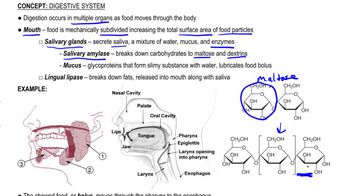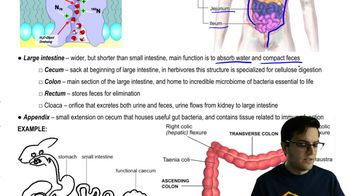SPEAKER: And Francis is known for his discovery, along with Jim Watson, of the structure of DNA. And he would occasionally indulge in a double bacon cheeseburger from Jack in the Box. And this ultimate cheeseburger contains more than 1,000 calories, 62 percent by fat alone. And since the requirement for an average person is only 2,000, this would be more than half your daily requirement, not counting the French fries and the Coke that he actually had on his table with him. And that would take you out for the day, that's for sure. Now food's a mixture of protein, carbohydrate, and fat, and we need the energy from these things to live on a daily basis. But we may not need all of it. And I'm going to take you on a journey as we take a bite of food and watch as it goes through our bodies from the outside to the inside and what happens to it and it goes through a series of scripted events. Here is the bite of food that through chewing is broken up and then through chemical events begins to be further processed in our bodies. Here it is in our stomach, where it's beginning to break up into its components. The little yellow droplets there are the lipids that we're going to track in more detail. And you'll see that these begin to break up into smaller components through biochemical action. And these will drift from our stomach into the intestine where absorption of nutrients occurs. And here at the microvilli in the intestine that take the fat from the outside, repackage it on the inside into something called chylomicrons, which travel through the lymphatics ultimately to the bloodstream, where this packaged fat is delivered to tissues such as the muscle, where can be used to bring energy, as is shown here. Or the excess that is not burned, remember the fat equation, the excess will be delivered in stored in adipose tissue. This shows some cells there and our chylomicron droplet delivering the excess energy where it's going to be stored in fat.
Table of contents
- 1. Introduction to Biology2h 40m
- 2. Chemistry3h 40m
- 3. Water1h 26m
- 4. Biomolecules2h 23m
- 5. Cell Components2h 26m
- 6. The Membrane2h 31m
- 7. Energy and Metabolism2h 0m
- 8. Respiration2h 40m
- 9. Photosynthesis2h 49m
- 10. Cell Signaling59m
- 11. Cell Division2h 47m
- 12. Meiosis2h 0m
- 13. Mendelian Genetics4h 41m
- Introduction to Mendel's Experiments7m
- Genotype vs. Phenotype17m
- Punnett Squares13m
- Mendel's Experiments26m
- Mendel's Laws18m
- Monohybrid Crosses16m
- Test Crosses14m
- Dihybrid Crosses20m
- Punnett Square Probability26m
- Incomplete Dominance vs. Codominance20m
- Epistasis7m
- Non-Mendelian Genetics12m
- Pedigrees6m
- Autosomal Inheritance21m
- Sex-Linked Inheritance43m
- X-Inactivation9m
- 14. DNA Synthesis2h 27m
- 15. Gene Expression3h 20m
- 16. Regulation of Expression3h 31m
- Introduction to Regulation of Gene Expression13m
- Prokaryotic Gene Regulation via Operons27m
- The Lac Operon21m
- Glucose's Impact on Lac Operon25m
- The Trp Operon20m
- Review of the Lac Operon & Trp Operon11m
- Introduction to Eukaryotic Gene Regulation9m
- Eukaryotic Chromatin Modifications16m
- Eukaryotic Transcriptional Control22m
- Eukaryotic Post-Transcriptional Regulation28m
- Eukaryotic Post-Translational Regulation13m
- 17. Viruses37m
- 18. Biotechnology2h 58m
- 19. Genomics17m
- 20. Development1h 5m
- 21. Evolution3h 1m
- 22. Evolution of Populations3h 52m
- 23. Speciation1h 37m
- 24. History of Life on Earth2h 6m
- 25. Phylogeny2h 31m
- 26. Prokaryotes4h 59m
- 27. Protists1h 12m
- 28. Plants1h 22m
- 29. Fungi36m
- 30. Overview of Animals34m
- 31. Invertebrates1h 2m
- 32. Vertebrates50m
- 33. Plant Anatomy1h 3m
- 34. Vascular Plant Transport2m
- 35. Soil37m
- 36. Plant Reproduction47m
- 37. Plant Sensation and Response1h 9m
- 38. Animal Form and Function1h 19m
- 39. Digestive System10m
- 40. Circulatory System1h 57m
- 41. Immune System1h 12m
- 42. Osmoregulation and Excretion50m
- 43. Endocrine System4m
- 44. Animal Reproduction2m
- 45. Nervous System55m
- 46. Sensory Systems46m
- 47. Muscle Systems23m
- 48. Ecology3h 11m
- Introduction to Ecology20m
- Biogeography14m
- Earth's Climate Patterns50m
- Introduction to Terrestrial Biomes10m
- Terrestrial Biomes: Near Equator13m
- Terrestrial Biomes: Temperate Regions10m
- Terrestrial Biomes: Northern Regions15m
- Introduction to Aquatic Biomes27m
- Freshwater Aquatic Biomes14m
- Marine Aquatic Biomes13m
- 49. Animal Behavior28m
- 50. Population Ecology3h 41m
- Introduction to Population Ecology28m
- Population Sampling Methods23m
- Life History12m
- Population Demography17m
- Factors Limiting Population Growth14m
- Introduction to Population Growth Models22m
- Linear Population Growth6m
- Exponential Population Growth29m
- Logistic Population Growth32m
- r/K Selection10m
- The Human Population22m
- 51. Community Ecology2h 46m
- Introduction to Community Ecology2m
- Introduction to Community Interactions9m
- Community Interactions: Competition (-/-)38m
- Community Interactions: Exploitation (+/-)23m
- Community Interactions: Mutualism (+/+) & Commensalism (+/0)9m
- Community Structure35m
- Community Dynamics26m
- Geographic Impact on Communities21m
- 52. Ecosystems2h 36m
- 53. Conservation Biology24m
39. Digestive System
Digestion
Video duration:
2mPlay a video:
Related Videos
Related Practice













![Anatomy and Physiology of the Large Intestine [Colon]](https://img.youtube.com/vi/F4W2DLIKXww/mqdefault.jpg)




![IGCSE BIOLOGY REVISION - [Syllabus 7.5] Absorption](https://img.youtube.com/vi/TEOB94oBZN4/mqdefault.jpg)


























